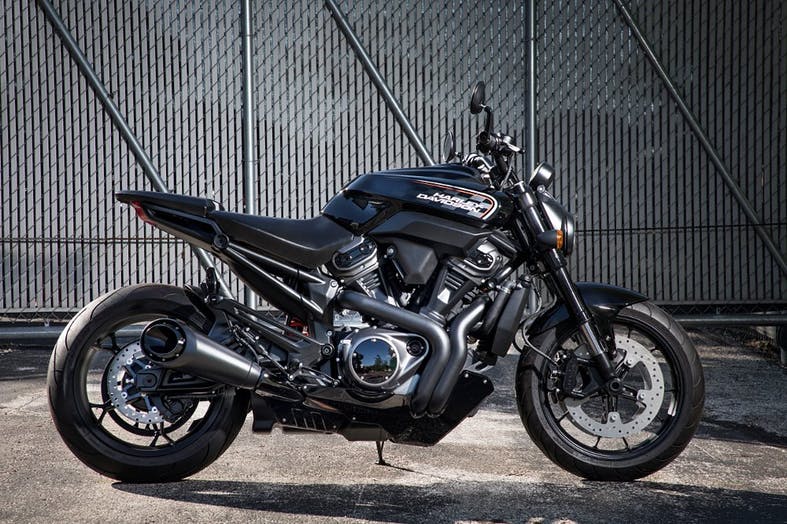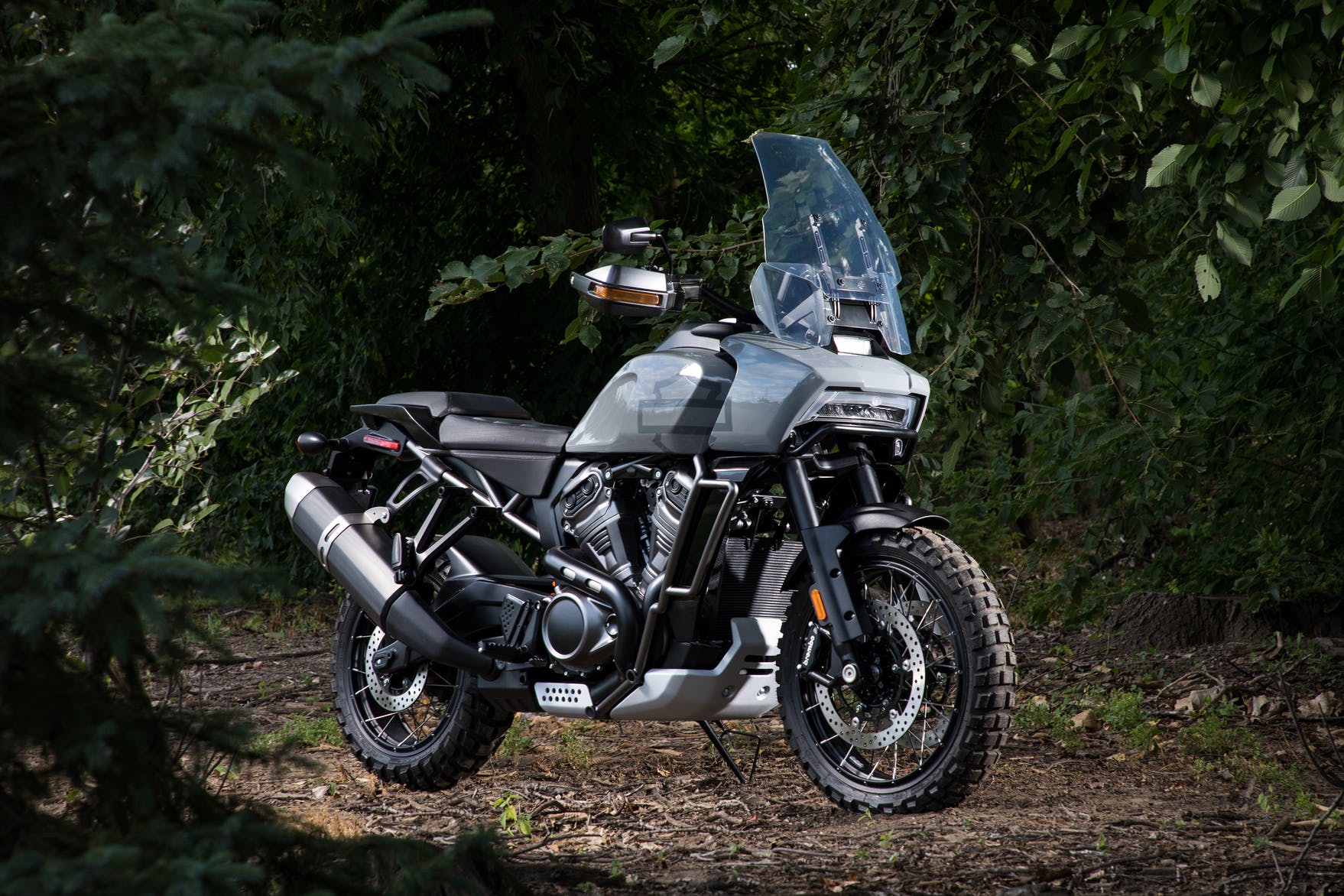
As someone who has ridden a Triumph Speed Triple for the last 20 years, the new streetfighter Harley-Davidson has planned looks interesting to me. But success will depend on the motorcycle being truly competitive. Gone are the days when Harley could sell motorcycles just for the name on the tank. Harley-Davidson photo.
I have to give credit to Harley-Davidson: It would have been easy to stick to their ways and ride the Good Ship Heritage all the way to the ocean floor, but they recognized they needed to do something dramatic if they want the company to remain strong and relevant for its second century. And — whether the new models announced today succeed or fail — they did something dramatic.
To be fair, Harley-Davidson’s leadership has recognized for nearly two decades that it needed to do something about its customer base. Its core customers have long been Baby Boomer white males in the United States. That’s a group that’s not getting any bigger and each year has fewer and fewer new motorcycle purchases in its future. It was a theoretical problem until the financial crisis, at which point Harley-Davidson went from having a waiting list for its motorcycles to seeing sales plummet, as the cheap home equity money dried up and the Boomers kept aging.
To varying degrees of success, Harley addressed this issue by reaching out to women riders and minorities. It also started looking more toward sales outside the United States. But what it did not do, successfully, was expand its lineup beyond traditional cruisers and touring motorcycles.
Arguably, the first effort was the V-Rod. It was different, but it didn’t really bring in new customers. Too expensive to attract younger riders and still an ungainly cruiser that didn’t appeal to sport-minded riders. Harley bought and later shuttered Buell. It bought MV Agusta for millions and sold it for pennies. More recently, it built the Street 500 and Street 750. They were still expensive and didn’t impress that many people.

The Harley-Davidson Pan America adventure-touring motorcycle, with a new 1,250 cc liquid-cooled V-twin engine, marks a serious departure from tradition for Harley-Davidson. Harley-Davidson photo.
Now, for something really different from Harley-Davidson
Today, Harley-Davidson announced truly different motorcycles: The Pan America, an entry in the adventure bike category that’s increasingly popular in the United States and has long been popular in Europe. Also coming are new, yet-to-be-named motorcycles in the “streetfighter” and “custom” categories (Harley’s terminology). And, as previously promised, the Livewire electric motorcycle will go into production next year. The other new models will have to wait for 2020 or 2021.
Also coming, according to Harley, are more electric models, including small models (electric bicycles now outsell motorcycles by wide margins in many parts of the world) and a 250 cc motorcycle to be built with a partner in Asia to sell in markets like India and Indonesia, places where more new motorcycles are purchased each month than are sold in the United States in an entire year.
Will it work?
Of course success will depend on execution. If the new motorcycles do not have competitive performance and pricing (and they face stiff and very well established competition, especially in the ADV category), they will fail. The days when Harley-Davidson could put out any product with a nice paint job and sell it based on the name on the tank are over. “Heritage” used to be a major asset for Harley. Now, it’s almost a liability. The Motor Company needs to attract young riders to replace the ones aging out, and many young people see Harley’s image and heritage as a negative, not a positive. They think “Harley” and what comes to mind is a slow, heavy, loud, expensive bike ridden by an older, gray-haired, overweight guy with a T-shirt that says “If you can read this, the bitch fell off.” In other words, nothing the vast majority of Millennials want to be a part of.
Harley-Davidson is suffering from trade wars and under occasional attack from the president, but those short-term problems pale in comparison to the long-term changes in consumer tastes and the negative demographic trends the company must overcome. Today’s announcement, on the eve of Harley-Davidson’s 115th birthday party, may not be enough to keep the company strong for another century, if the motorcycles themselves aren’t good enough. But it’s exactly what the company needed to do.

Curiously, *just*the*other*day* I watched a guy ride by on V-Rod and thought for very first time, “You know, it looks alright.”
Harley CEO Matt Levatich has bet the company with this move, as well as his own reputation. It might be too little, too late, and if so it will not work. But at this point, it’s the only thing that might work.
The all-new ICE models will have to survive some tough comparisons to well-developed bikes the likes of the Multistrada and GS, and any number of strong Japanese ‘nakeds’. The EVs however, will still be relatively alone in the marketplace. Way back in 2014 when I rode the first Livewire, I thought leapfrogging higher tech ICE models and going straight to EVs was Harley’s only chance at credibility with hip young riders. I still think that is true.
There’s a lot left to be seen, but one key thing will be how the company and especially the dealer network get behind (or sabotage) the new bikes. Buell’s the cautionary tale here, but when dealers were spurning Buells, they could sell all the new Harleys they wanted. Now, maybe the dealers realize that desperate times call for bold measures.
I agree, Mark. If the new models fail it will be because they don’t measure up to the competition. And if it’s too late it will be because we’ve reached a point where x(n) < y(n), where x = people who think Harley-Davidson's image and "heritage" make it attractive, y = people who think Harley-Davidson's image and "heritage" make it undesirable, and n = number of new motorcycles those individuals will buy in their remaining years. We may have reached that tipping point, where the Harley image, "mystique," heritage, etc., have gone from an asset they could bank on to a liability they have to change.
I think Mark hit most of my points in his comments. At this point I think H-D only has one choice, go out on the limb and give it a shot. They can, and hopefully will, always offer cruisers, but they must change their image, and the way they build motorcycles to be viable. I don’t want Harley to stray too far from simplicity, because that can be a strength, but there are things that can certainly use an update.
My eyes are locked on the Pan-American. That bike has HUGE potential… assuming it’s not overpriced. I think they need to take aim square at the Super Tenere and see how things shake out. Going toe-to-toe with KTM and BMW is a losing battle if they put the price tag on par with BMW’s flagship.
Ultimately I’m still holding out for a Scrambler, but I’ll happily take this new Harley Adventure for a spin in the dirt.
While I’m clearly on the record as believing Harley-Davidson had to do this, I think the Pan America has a small chance of being a big success. I agree with you that few KTM and BMW fans will be lured away to buy a Harley ADV bike. And how many Super Teneres are sold per year in the United States? I don’t know the answer, but I know it’s not many. Yamaha can afford to sell a couple thousand units of a bike in the United States and be happy, but for Harley, that number does not move the needle.